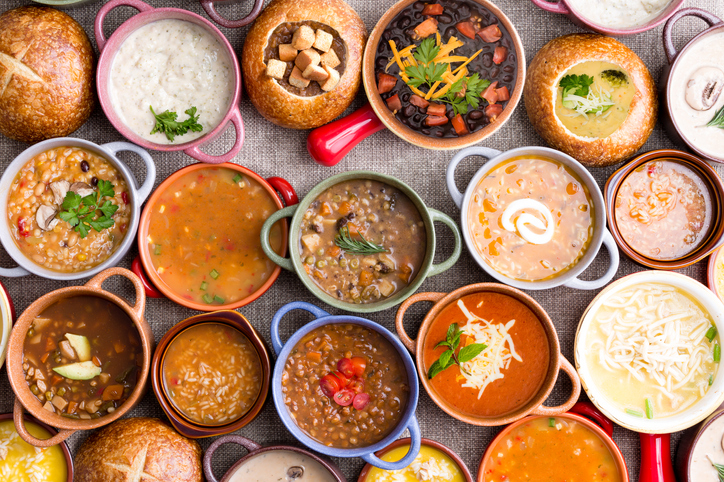Let's face it: there's more to a business lunch than just eating. It's a chance…
Essential Ingredients for the Perfect Homemade Soup

Creating the perfect bowl of homemade soup begins with understanding the essential soup ingredients that form the heart of each nurturing spoonful whether a novice or a seasoned cook, the right blend of elements is key to crafting easy soup recipes that boast depth, flavor, and nutrition.
In this blog post, we will assist you in discovering creative homemade soup ideas that will help you effortlessly master simple soup recipes with satisfying results. So, come along and join us in the art of soup-making, where your kitchen can become a place of warmth and wellness.
Keep reading to uncover the secrets of the perfect homemade soup and discover how Kate’s Kitchen brings these flavors to life in every meal!
Understanding the Basics of Soup Making
Before beginning, it’s essential to grasp the fundamental roles that various ingredients for homemade soup play in crafting a truly heartwarming dish. Every ingredient, simmer and stir, plays a vital role in creating a symphony of flavors when making soup at home. By carefully selecting high-quality soup ingredients and utilizing traditional techniques, you can create a dish that not only satisfies hunger but also expresses your culinary passions.
Whether it’s a gently spiced broth or a robustly thickened chowder, your homemade soup is a canvas for creativity, nutrition, and tradition. With guidance from well-thumbed pages of soup lore and contemporary culinary wisdom, we’ll cover the cornerstones of soup-making that will transform your home kitchen into a sanctuary of flavor and nutrition.
The Foundation: Broths and Stocks
The rich tapestry of flavors in homemade soup begins with its base – the broth or stock. These liquid foundations absorb the essences of anything they touch, hence the insistence on simmering them gently to achieve a depth that sets the tone for your dish. The homemade soup recipes that are most memorable are ones that require a long simmer, with carefully browned bones, vegetables, and seasoning added in.
Aromatic Ingredients: Building Flavor Layers
Aromatic components – the trinity of onions, garlic, and celery – act as the backbone for many successful homemade soup recipes. These ingredients introduce complexity and richness into the soup’s profile. By sweating them slowly, you unlock a tapestry of fragrances that forms the perfect canvas for adding other fresh soup ingredients.
Vegetables in Soup: Choosing Quality Produce
When creating a delicious homemade soup, one of the most important factors contributing to its taste and overall quality is the selection of vegetables you choose to use. It’s not just about choosing any old carrot, potato, or leek – the vibrancy and flavor of your soup will depend on selecting produce that is fresh, flavorful, and of high quality. By selecting the best produce available, you can ensure that your homemade soup bursts with flavor and nutrients and is a true delight for the senses.
Meats and Alternatives: Adding Substance
One of the best ways to add substance to soups is by incorporating proteins, which can transform them from starters into substantial soups. Not only do proteins lend a satisfying chew, but they also boost the nutritional value of the soup, making it a complete and balanced meal.
Thickening Agents: Achieving the Ideal Soup Consistency
When you’re making soup at home, the quest for that perfect texture leads us to an essential step: thickening. Let’s delve into the world of thickening agents that are central to homemade soup recipes and essential soup ingredients in their own right.
A roux, formed from equal parts fat and flour cooked together, acts as a traditional thickener, providing a velvety mouthfeel to dishes such as gumbo and chowder. Cornstarch, a gluten-free alternative, offers clarity and gloss, making it ideal for Asian soups and sauces. Arrowroot powder, another gluten-free option, is heralded for thickening acidic liquids where cornstarch might fail.
- Roux-based soups are best when you’re craving something hearty.
- Cornstarch is your ally for a clear, glossy finish, perfect when you’re striving for a delicately thickened broth.
- Arrowroot is the go-to for those needing a thickener that stands up to acidity and freezing, ideal for fruit soups and when planning to store leftovers.
By selecting the right thickening agent, you can ensure your soup’s consistency complements its flavor without stealing the spotlight—a balancing act worthy of the finest soup artisans.
Herbs and Spices: The Secret Ingredients for Homemade Soup
As you embark on how to make soup from scratch, you’ll discover the transformative power of herbs and spices. These best soup ingredients are not just afterthoughts but essential to crafting a pot that exudes flavor and health benefits. Integrating these elements into your homemade soups heightens the taste and boosts the nutritional value, making them an integral part of healthy soup ingredients.
Must-Have Herbs for Flavorful Soups
When it comes to preparing soup, the freshest herbs that you should always keep on hand are parsley, thyme, and bay leaves. These herbs will help enhance your soup’s aroma, providing a unique freshness that cannot be achieved with other ingredients. Parsley adds a pop of color and a clean, peppery taste to your soup. Thyme, on the other hand, contributes an earthy and slightly floral flavor to your broth. Lastly, bay leaves offer a subtle depth that complements the other flavors in your soup.
Spice It Up: Adding Depth to Your Soup
Let’s dive into the many spices that can help enhance the flavor of your soups. Paprika adds a sweet note and rich color, while cumin contributes its distinctive warm and earthy essence. Turmeric, highly regarded for its anti-inflammatory properties, imparts a vivid golden hue and a mild, bitter zest, turning a simple soup into a bowl of curative wonder. Discovering these vibrant spices is pivotal in learning how to make soup from scratch that’s both delicious and beneficial to your health.
Combining Spices for Unique Flavor Profiles
A masterful symphony emerges when spices are artfully combined. This strategic melding of complexities creates an individualistic character for each batch of soup you prepare, distinguishing your homemade soup from any other and showcasing your culinary creativity with even the simplest of easy soup recipes. You can also experiment with blending different spices to develop your unique flavor profiles.
Soup-Making Tips: Elevating Your Homemade Soup Recipes
Embarking on the path of how to make soup from scratch means embracing the entire process, from selecting quality soup recipe ingredients to applying tried-and-true techniques that ensure each spoonful is a taste of comfort. Let’s dip into some of these transformative strategies:
- Begin with “mise en place,” the chef-endorsed practice of organizing and arranging the ingredients you’ll need for your soup recipe before starting. This streamlines your cooking process and ensures that no important component is forgotten.
- Don’t underestimate the power of dry-roasting your spices. This simple step can magnify their flavors, ensuring that your easy soup recipes are anything but bland.
- Layering is your secret weapon. By adding your soup recipe ingredients in stages, you can build a complex profile of flavors, giving your soups an exquisite depth that’s apparent in every mouthful.
- Delicate herbs should be added towards the end of your cooking to preserve their vibrant colors and flavors, while sturdier herbs and spices can be added earlier to infuse the broth thoroughly.
- Do taste as you go. Your palate is the ultimate guide in tweaking the seasoning to perfection, distinguishing between a good soup and a great one.
Nurturing Your Soup: Simmering Techniques and Times
Once you’ve gathered your essential soup ingredients and embarked on creating homemade soup recipes, understanding the crucial role of a simmer is pivotal. The following insights will guide you to achieving outstanding flavors and textures, turning your soup recipe ingredients into a comforting masterpiece.
The Importance of Cooking Time in Soup-Making
Cooking time is critical in soup-making. The interplay between heat and time profoundly impacts how the elements of your soup meld. Too brief of a simmer, and the flavors may remain raw and separate; too long, and your ingredients may lose their texture and vitality.
Adjusting simmer times allows the individual flavors of your chosen soup ingredients to merge into a harmonious whole, making each spoonful of your homemade soup recipes a testament to your culinary intuitiveness.
Simmering vs. Boiling: What’s Best for Soup?
A gentle simmer is crucial when making soup. This method delicately circulates your homemade soup ingredients, allowing them to tenderize without disintegrating and infusing the broth with their essence without evaporating the nuanced flavors and essential nutrients that nourish homemade soup recipes.
Slow Cooker Soup Tips for Busy Home Chefs
Here are some slow cooker soup tips that turn minutes of prep into hours of flavor development. Embrace these techniques to transform your essential soup ingredients into a slow-cooked sensation. With a slow cooker, your homemade soup recipes can patiently develop complexity, layer by layer, while you tend to your bustling schedule.
The result? Rich, hearty soups that taste like they’ve been stirred by the spoon of a watchful chef all day long.
The Finishing Touches: Textures and Toppings
As you near the completion of your easy soup recipes, a moment arises for artistic flair. As chef Antoine Rivoire explains in “Soup Finale,” applying texture and toppings can profoundly impact the final dish. Let’s explore how to incorporate these elements into a soup that delights all the senses.
Crunch and Creaminess: Balancing Textures
Understanding the balance of textures is like adding the final brushstroke to a masterpiece. Here’s how you can introduce that tantalizing contrast to your soups:
- A dollop of cream or a swirl of Greek yogurt can introduce a luxurious creaminess that smooths out the complexity of your popular soup ingredients.
- Consider a sprinkle of homemade croutons over a rich tomato bisque or a handful of toasted pumpkin seeds atop a velvety squash soup for a playful crunch.
- An aromatic drizzle of infused oil, such as basil or rosemary oil, carries both flavor and a slick texture, making every bite more intriguing.
Discover the Family-Friendly Dining Experience at Kate’s Kitchen
Making soup at home is more than just mixing ingredients—it’s about layering flavors, textures, and love into every bowl. Applying these handy soup-making tips will unlock the full potential of your easy soup recipes, turning the simple act of soup crafting into an artful expression of your culinary prowess.
At Kate’s Kitchen, we believe every meal should be an experience of comfort and joy. Our doors are open to welcome you into a world where homemade tastes meet family-friendly vibes.
Whether you’re craving a classic breakfast to start your day right or longing for a lunch that feels like a hug in a bowl, our menu has all the essentials. We’re dedicated to having fresh, high-quality ingredients, and it’s our passion to create meals that warm your heart, and that is what sets us apart.
Don’t miss out on the chance to create unforgettable memories around the table with your loved ones. Come visit us at Kate’s Kitchen today to experience the true essence of homemade cooking, crafted with care and served with a smile.




